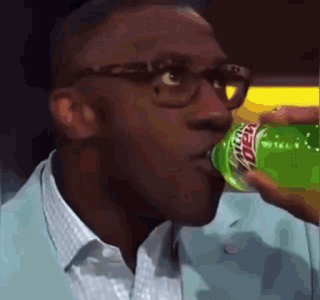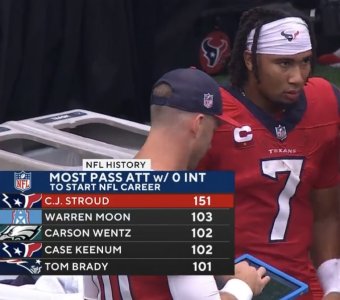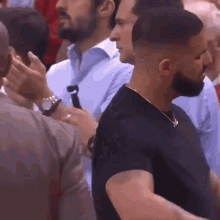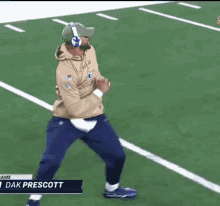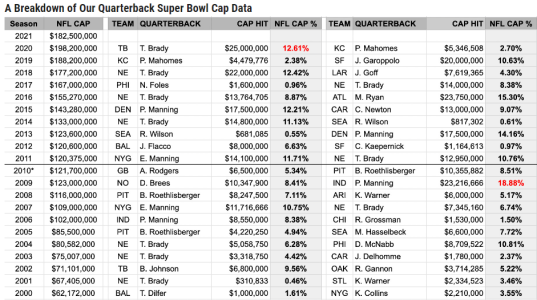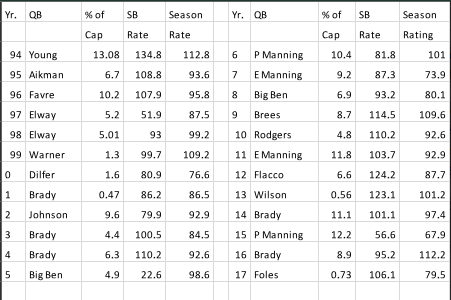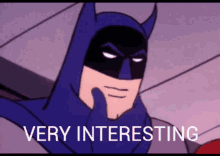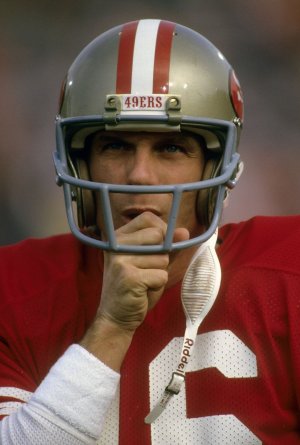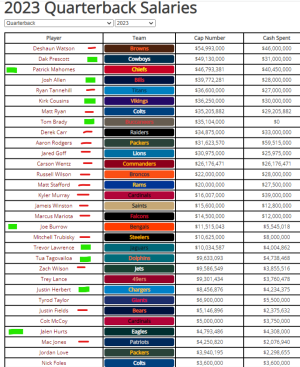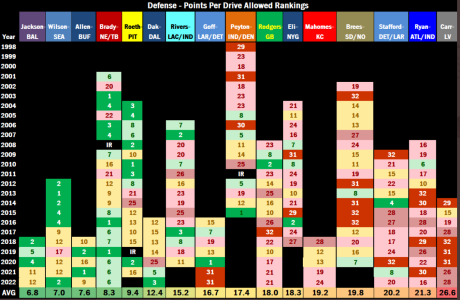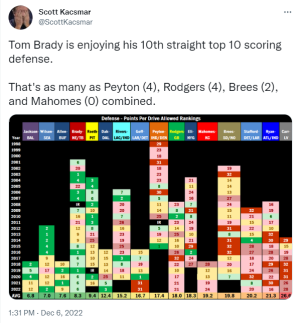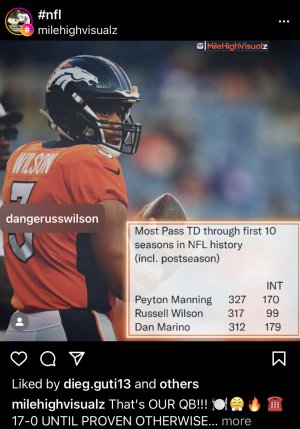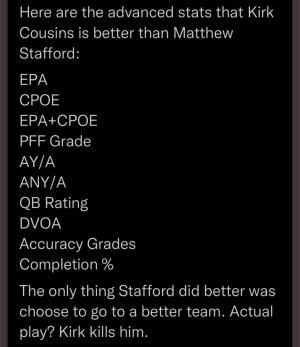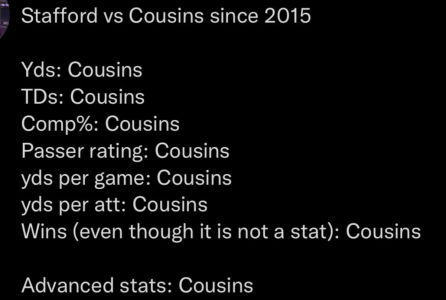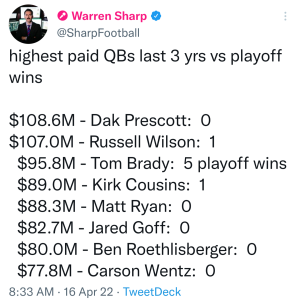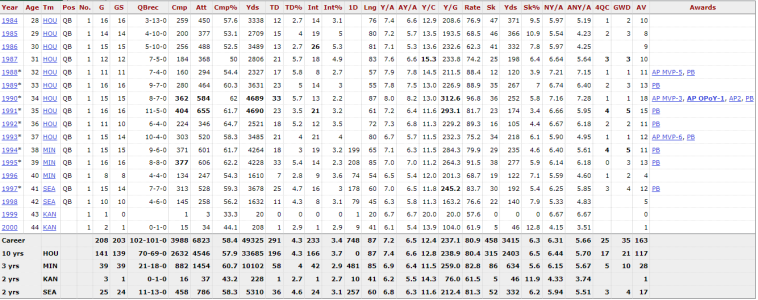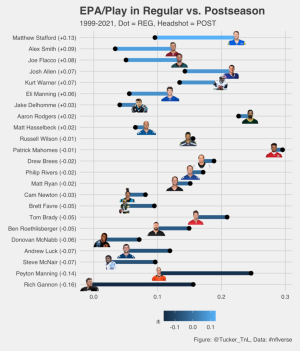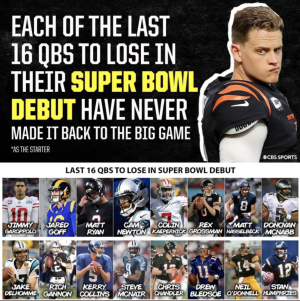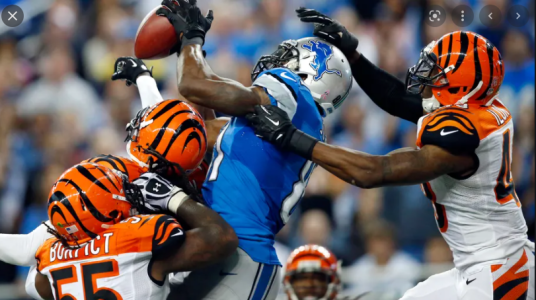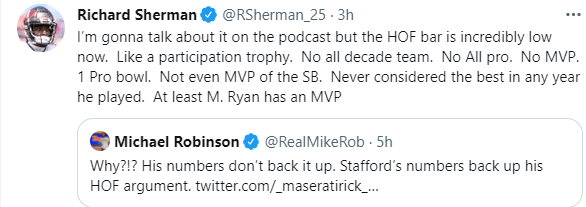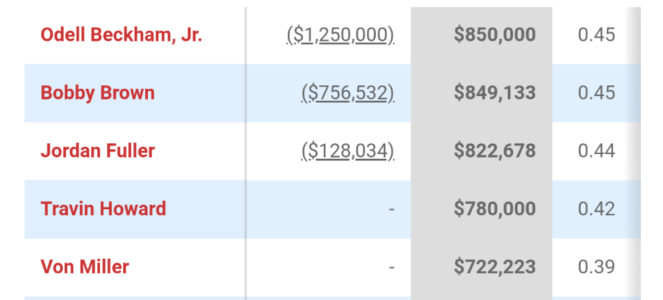Navigation
Install the app
How to install the app on iOS
Follow along with the video below to see how to install our site as a web app on your home screen.

Note: this_feature_currently_requires_accessing_site_using_safari
More options
You are using an out of date browser. It may not display this or other websites correctly.
You should upgrade or use an alternative browser.
You should upgrade or use an alternative browser.
QB THREAD - 2x quarterbacky award winner: Lamar Jackson
- Thread in 'Sports & Training' Thread starter Started by 651akathepaul,
- Start date
- 22,885
- 2,317
- Joined
- Oct 13, 2000
Actually I never said Russell was better. I said so far at the time Russell and a better career than Luck, which was true. I also said I thought Luck would have a better career at the end of the day
Very fair statement
I'm honestly impressed with him this year, but, I've seen hot stretches from him before.
I want to be sure, but so far, LOVE what I've seen last 3-4 week's.
And I never said he was a game manager, did I????
Oh no
 I've been calling him that lately. He's making good throws and cutting down the mistakes. Doing a good job of taking advantage of worn down defenses so I'm still a little hesitant to start crowning him back to what he's been the last few years stat wise. I'm afraid but curious to see what a shootout or a game without DeMarco would look like.
I've been calling him that lately. He's making good throws and cutting down the mistakes. Doing a good job of taking advantage of worn down defenses so I'm still a little hesitant to start crowning him back to what he's been the last few years stat wise. I'm afraid but curious to see what a shootout or a game without DeMarco would look like.- 15,661
- 4,793
- Joined
- Apr 12, 2008
#protectyourQB
Greg Bedard on Drew Brees and the other two old QB's:
 Shout out to the Lions' front though, they're beastin' this year.
Shout out to the Lions' front though, they're beastin' this year.
Full Article.
Greg Bedard on Drew Brees and the other two old QB's:
8 pressures in 11 dropbacks.In many ways, the Saints’ problems are very similar to what the Patriots were going through during the first four games of the season. Drew Brees is getting pressured way too much. Whether that’s a result of Payton’s lack of patience with the running game, the offensive line not blocking well, or Brees not seeing the field clearly, it’s hard to say. It’s probably, like most things, a combination of everything.
Brees (age 35), Tom Brady (37) and Peyton Manning (3are the aging pocket quarterbacks in the league. They have carried their teams for a long time. They just can’t do it when they are pressured one out of every four snaps. That’s why, on the same day Manning is being celebrated for setting the league’s all time mark for career passing touchdowns in a blowout win over the 49ers, Brees is struggling and Brady’s Patriots barely squeaked by the outmanned Jets.
Pressure affects every quarterback, no matter how talented they are, be it in the form of sacks, hits or hurries. Pressure speeds up passers—especially those that operate strictly from the confines of the pocket. It throws them off rhythm. They don’t anticipate receivers coming open. They rush through their progressions.
Look at the difference in pressure felt by Brees, Manning and Brady in their games so far (data thanks to ProFootballFocus.com) and it’s clear who has been successful and why.

In his six games this season, Brees has been pressured at least 25 percent of the time in five of those games. Brees got his best protection (21.1 percent pressure) in the win over the Vikings. In total, Brees has been pressured on 29.2 percent of his dropbacks.
Brady has felt pressure on more than a quarter of his dropbacks in four of his seven games. Those four games included the Patriots’ two losses (when Brady was pressured 40.0 and 42.3 percent of the time), with the other two narrow home victories over the Raiders and Jets (teams that are 1-12 combined). For the season, Brady has been pressured more than Brees (30.8 percent).
Then there’s Manning. He has crossed the 25 percent pressure threshold only twice: the loss against the Seahawks and the struggle against the Jets. Manning has been pressured on less than 19.2 percent of his snaps in four of his six games. Neither Brees nor Brady has been kept that clean in any game
For Brees, the final two drives against the Lions were a microcosm of the season thus far. On 11 dropbacks over the final two drives (one a run by Brees), he was pressured eight times, including the interception with 3:20 to play that allowed the Lions to take the lead. Brees has to find a way not to make that mistake, but those things happen when you’re constantly feeling the heat.

Full Article.
Last edited:
- 29,014
- 4,130
- Joined
- Jan 3, 2004
You like Bedard iLLoquent?
Dude was writing for GB before he went to the dark side. Seemed like a good dude... Tweeted me back a few times about random **** like where to eat in Green Bay.

Dude was writing for GB before he went to the dark side. Seemed like a good dude... Tweeted me back a few times about random **** like where to eat in Green Bay.

- 37,287
- 19,666
- Joined
- Nov 17, 2004
Good article. I wonder what Matt Stafford's pressure %'s look like. Dude is getting killed every game.
- 15,661
- 4,793
- Joined
- Apr 12, 2008
He is EXCELLENT at what he does. Might be my fav. NFL beat guy. Even though he's gone national w/ SI and MMQB, Bedard still has a weekly local sports radio segment where he discusses the Patriots and everything else going on in the league. All he does is watch a ton of tape, studies all the #'s and calls it how he sees it. He doesn't pump out tired *** narratives like a lot of these other dudes out here.
He catches stuff you wouldn't normally notice on a typical play. Much, MUCH better than his current boss.
He catches stuff you wouldn't normally notice on a typical play. Much, MUCH better than his current boss.
- 37,287
- 19,666
- Joined
- Nov 17, 2004
Good article. I wonder what Matt Stafford's pressure %'s look like. Dude is getting killed every game.
Kap as well.
The 49ers Oline regression is baffling.
I understand some injuries hit but Jesus.
Kaep already has questionable decision making at times, add-in an o-line that gives him like 2.5 seconds to throw the ball and :x
VD and Crabs also have the dropsies this year.
All bad.

- 29,014
- 4,130
- Joined
- Jan 3, 2004
Maybe they just have VD and Crabs this year.
- 37,287
- 19,666
- Joined
- Nov 17, 2004

- 12,236
- 2,403
- Joined
- Nov 12, 2013
- 27,979
- 9,062
- Joined
- Nov 18, 2007
Shouldn't be baffling given what you just said about injuries.Kap as well.
The 49ers Oline regression is baffling.
I understand some injuries hit but Jesus.
-Anthony Davis......been hurt. Has played 2 games IIRC.
-Alex Boone......Held out all of training camp. Has played ok, but not as great has he has in the past. Coming around though.
-Mike Iupati......dude sucks in pass protection. But he is amazing in run blocking, which is why he is/has been an All-Pro. His pass protection has always been suspect.
-Daniel Kilgore......is replacing a quality center and is a first year starter. He has been ok, not great. But he just got hurt for the season so its rookie Marcus Martin's time to step up.
-Joe Staley.....Staley is Staley. He is a great tackle.
Should be fairly easy to see why Kap has been running for his life all season.
- 29,014
- 4,130
- Joined
- Jan 3, 2004
Grantland piece on QB contracts:
http://grantland.com/the-triangle/quarterback-contracts-andrew-luck-russell-wilson-cam-newton/ Formatting is being dumb... Its long as most most things grantland puts out are... Top part is in the quote, the rest in spoiler or just click the link.
http://grantland.com/the-triangle/quarterback-contracts-andrew-luck-russell-wilson-cam-newton/ Formatting is being dumb... Its long as most most things grantland puts out are... Top part is in the quote, the rest in spoiler or just click the link.
[h2]The Quarterback Contract Question[/h2]
KIRK IRWIN/GETTY IMAGES
NFL
OCTOBER 24, 2014
by BILL BARNWELL
Where does your team quarterback’s come from? Most likely, he comes from your team’s selection during the NFL draft. Of the league’s 32 starters, three were acquired by trade[sup]1[/sup] (Carson Palmer, Alex Smith, and Jay Cutler), six were veteran free agents (Kyle Orton, Brian Hoyer, Ryan Fitzpatrick, Drew Brees, Colt McCoy, and Peyton Manning), and two were undrafted rookie free agents (Tony Romo and Austin Davis), with the remaining 21 taken by their current teams in the NFL draft. Thirteen of those 21 were drafted in the first round, with just two — Tom Brady and new Titans starter Zach Mettenberger — coming off of the board after Round 3.
In other words, unless you draft and develop your own quarterback, the chances of you finding another one in the free-agent market are slim. Everybody wants a Russell Wilson, a guy who makes a few hundred thousand bucks and plays like he’s one of the best quarterbacks in football. That’s great. What’s more realistic is to find your quarterback, hold on to him for a while, and value him properly throughout his life span with your team.
Take Ted Thompson, one of the best general managers in football. When Thompson took over as Packers general manager in 2005, he inherited a 10-6 team with a star quarterback, 35-year-old Brett Favre. His first pick, the 24th overall selection in the first round of the 2005 NFL draft, was Cal quarterback Aaron Rodgers.
Rodgers spent his first three years as Favre’s understudy[sup]2[/sup] before taking over after Favre’s first “retirement” in 2008. In Rodgers’s first seven starts before Green Bay’s bye week, he posted an impressive 98.8 passer rating while throwing 12 touchdowns against four picks. With a year and a half left on Rodgers’s rookie deal, Thompson might have been right to wait and see whether Rodgers kept that pace up. Instead, he used the leverage of that rookie deal to sign Rodgers to a six-year, $63.5 million extension.
During that contract, Rodgers would become the league’s best quarterback while he was making about what Kevin Kolb received from the Cardinals. For Thompson, it wasn’t just about finding a star quarterback on a rookie deal; he carved out a second contract for Rodgers that delivered tons of value for the Packers, too, helping them to eventually win a Super Bowl.
Likewise, other general managers have to stay on top of the market to evaluate and plan out their own quarterback’s contracts. There were very few comparables for Rodgers when he signed his first extension, because nobody else in recent memory had sat out three full seasons before entering into the lineup and playing at an immediately high level. By the time he was ready to sign his second extension in 2013, of course, Rodgers’s comparables were obviously the very best quarterbacks in football, so he got a contract similar to them.
Recent contract extensions have split in a couple of different ways. There’s the traditional contract extension, the old-school deal that gives a quarterback a hefty signing bonus up front with meaningful base salaries, most of which aren’t guaranteed. The quarterback gets his cash and holds leverage by virtue of the team owing massive amounts of salary-cap acceleration if it chose to get rid of him in the first few years of the deal.Joe Flacco’s deal, with a $29 million signing bonus, a $15 million option bonus paid in the second year of the deal, and just one guaranteed base salary, is a classic old-school deal.
More recently, quarterbacks (often of a lesser caliber) have been signing new-school extensions. These deals don’t give a quarterback a huge up-front signing bonus but instead guarantee multiple years of hefty base salaries. They give the team more flexibility in moving on from a player quickly without having to be concerned about the long-term cap implications of trading or cutting a guy after two or three seasons. The contracts of Jay Cutler, Colin Kaepernick, and Andy Dalton are variants of the new-school extension.
We’re currently in a very important time for extensions. The unprecedented crop of young quarterbacks who have emerged over the past couple of seasons have either already signed extensions, are about to sign extensions, or are about to be judged as worthy of a future extension. (Sorry, RG3.) Meanwhile, the members of the legendary Class of 2004 are all just about due for an evaluation, with Philip Rivers, Eli Manning, and Ben Roethlisberger all set to be unrestricted free agents in 2016.
With that in mind, let’s split the league’s quarterbacks (the starters and a notable key backups) into a few key groups and evaluate their situations, both in the moment and in the markets of the years to come. I’ll be providing a few relevant pieces of information for each quarterback in a table:
• The Expiration Year (FAYr), which is the offseason during which the quarterback will hit free agency without an extension or an early release.
• The Earliest Decision Year (EDYr), which is the first offseason during which a team will reasonably have an opportunity to release a quarterback without utterly destroying its cap in the process. The Cowboys could have theoretically cut Tony Romo this offseason if they had drafted Johnny Manziel, but if they had done so, it would have taken Romo’s cap hold of $11.8 million (itself already lowered by much-needed restructuring) and shoved it all the way up to a dead money charge of $49.2 million. For aperennially cap-strapped team, that would have been impossible. In 2016, though, the Cowboys can pay Romo $17.6 million or release him and have just $11.6 million in dead money on their cap; that’s the first time they can really justify moving him, and so it’s the Earliest Decision Year. In cases in which a team can already get rid of a guy without having to incur a serious financial penalty, I’ve left the EDYr blank.
• His 2014 Cap Hit and the total length of his contract in Years.
• Finally, the Three-Year Value (3YV) of the deal, which assumes a player will make it through the first three years of his contract and receive the money waiting for him. Most NFL teams use some variant of the three-year value in their own internal accounting of what each player in the league is making. This is always a little murky, because NFL contracts fold up on one another and get twisted along the way. For some like Roethlisberger, the three-year value of his deal came and went years ago, while others (notably Kaepernick) have their three-year value calculated on a contract extension that begins in 2015 and doesn’t even have much in the way of guarantees. This includes the player’s full signing bonus (even if it’s spread, for cap purposes, across several seasons). Consider it an estimate as opposed to a hard fact.
Let’s start with the passers who don’t have to worry about this stuff for another year or two and work our way toward the guys who are about to get new deals. Note that all of the contract info comes from the indispensableSpotrac.
[h2] [/h2]
[h2]Group 1: The Young Guns[/h2]
[table][tr][th=""]Team[/th][th=""]Quarterback[/th][th=""]FAYr[/th][th=""]EDYr[/th][th=""]2014 Hit[/th][th=""]Years[/th][th=""]3YV[/th][/tr][tr][td]JAC[/td][td]Blake Bortles[/td][td]2018[/td][td]2018[/td][td]$3,755,420[/td][td]4[/td][td]$17,418,245[/td][/tr][tr][td]BUF[/td][td]EJ Manuel[/td][td]2017[/td][td]2017[/td][td]$2,019,386[/td][td]4[/td][td]$7,268,668[/td][/tr][tr][td]CLE[/td][td]Johnny Manziel[/td][td]2018[/td][td]2017[/td][td]$1,499,745[/td][td]4[/td][td]$6,703,605[/td][/tr][tr][td]MIN[/td][td]Teddy Bridgewater[/td][td]2018[/td][td]2017[/td][td]$1,245,364[/td][td]4[/td][td]$5,495,479[/td][/tr][tr][td]OAK[/td][td]Derek Carr[/td][td]2018[/td][td]2016[/td][td]$976,691[/td][td]4[/td][td]$4,219,280[/td][/tr][tr][td]NYJ[/td][td]Geno Smith[/td][td]2017[/td][td]2015[/td][td]$1,140,819[/td][td]4[/td][td]$3,653,784[/td][/tr][tr][td]TB[/td][td]Mike Glennon[/td][td]2017[/td][td]–[/td][td]$705,469[/td][td]4[/td][td]$2,275,782[/td][/tr][tr][td]TEN[/td][td]Zach Mettenberger[/td][td]2018[/td][td]–[/td][td]$451,279[/td][td]4[/td][td]$1,655,116[/td][/tr][tr][td]STL[/td][td]Austin Davis[/td][td]2016[/td][td]–[/td][td]$570,000[/td][td]1[/td][td]$570,000[/td][/tr][/table]
The first-round picks in this group — Bortles, Manuel, Manziel, and Bridgewater — each have a fifth-year team option automatically attached to their contracts. As a top-10 pick, Bortles’s fifth-year option would require him to receive the equivalent of the transition tag for quarterbacks; Cam Newton, who will get the fifth-year option next year, is getting $15 million for his fifth-year option. Players taken after the 10th overall spot get the average of the players who are paid between third and 25th at their position.
We don’t know anywhere near enough about the likes of Bortles or Bridgewater to know whether their fifth-year options will get picked up, but it would be safe to say that Manuel’s will not. The other guys are on strict four-year contracts that have no option attached.
Davis’s deal is quickly becoming a very interesting proposition. For years, the Rams have been a team with tons of undervalued talent outside of quarterback, where they were dumping millions of dollars into a disappointing no. 1 pick. With Sam Bradford likely to be released after the year, this will be the last season for rookie contracts from the old CBA, which is how Bradford’s cap hit ($17.6 million) is larger than that of anybody who suited up for the Broncos or Chargers last night.
Davis represents a total flip of the script; as the Rams give out massive deals to the likes of Robert Quinn, Davis appears to be a competent quarterback at a sale price. The one thing the Rams will have to worry about is restricted free agency. The concept was basically written into the history books with the new CBA, but Davis would be one of the few veterans who would qualify for restricted free agency. The Rams will have to tender him a deal at one of four levels, which will most likely be the most expensive level. That would pay Davis $3.1 million while forcing a team interested in Davis to pony up a first-round pick to acquire him.
I don’t think anybody would give the Rams a first-round pick for Davis and blow them away with an unmatchable offer sheet, but stranger things have happened. More likely, Davis gets this year and next year to prove himself before the Rams either give him a long-term extension or move on.
[h2]Group 2: Sealed for Years (The Old-School Way)[/h2]
[table][tr][th=""]Team[/th][th=""]Quarterback[/th][th=""]FAYr[/th][th=""]EDYr[/th][th=""]2014 Hit[/th][th=""]Years[/th][th=""]3YV[/th][/tr][tr][td]DAL[/td][td]Tony Romo[/td][td]2020[/td][td]2016[/td][td]$11,773,000[/td][td]6[/td][td]$61,364,833[/td][/tr][tr][td]NO[/td][td]Drew Brees[/td][td]2017[/td][td]2015[/td][td]$18,400,000[/td][td]5[/td][td]$60,500,000[/td][/tr][tr][td]DET[/td][td]Matthew Stafford[/td][td]2018[/td][td]2016[/td][td]$15,820,000[/td][td]3[/td][td]$59,500,000[/td][/tr][tr][td]GB[/td][td]Aaron Rodgers[/td][td]2020[/td][td]2017[/td][td]$17,550,000[/td][td]5[/td][td]$56,300,000[/td][/tr][tr][td]ATL[/td][td]Matt Ryan[/td][td]2019[/td][td]2017[/td][td]$17,500,000[/td][td]6[/td][td]$51,000,000[/td][/tr][tr][td]BAL[/td][td]Joe Flacco[/td][td]2019[/td][td]2017[/td][td]$14,800,000[/td][td]6[/td][td]$47,750,000[/td][/tr][tr][td]NE[/td][td]Tom Brady[/td][td]2018[/td][td]2018[/td][td]$14,800,000[/td][td]5[/td][td]$47,200,000[/td][/tr][/table]
Romo has the largest contract in this group because he had the most leverage at the time of extension and plays for a team that has already needed to restructure his contract twice in two years. It will cost the Cowboys just as much to pay Romo next year as it would to release him, but given that his cap hit rises from $11.8 million all the way to $27.8 million, Dallas will surely renegotiate and kick the can further into the future.
Meanwhile, Flacco’s contract detonates in its fourth season, 2016, when his cap hit nearly doubles, going from $14.6 million all the way to $28.6 million, without much in the way of flexibility for Baltimore to either push some of that money into the future or move on from Flacco. It would owe $25.9 million in dead money if it cut Flacco in 2016. Baltimore might instead need to give him a new contract extension at that time to dump some of the bonuses due him into the future.
There’s something interesting brewing in New Orleans with Brees. I don’t know that it makes a ton of sense for the Saints to move on, given how well Brees has played before this year, but they’re already in cap hell for 2015 and one of the few ways they would be able to create some cap space would be to cut Brees, a move that would save the team $11.6 million. I strongly doubt that will happen, but if Brees were to continue to slowly decline from his current level of play, wouldn’t you at least think about moving on from him in 2016, the final year of his deal, when he would cost $27.4 million on the active roster versus just $7.4 million in dead money?
I covered the Brady contract in Week 5, when the first rumors started to leak that Brady might want to finish his career elsewhere. I don’t think that’s going to happen, especially since he’ll be on the active roster for the remainder of the 2014 season. That guarantees his base salaries through 2017, making it impossible to cut him.
[h2]Group 3: Sealed for Years (New-School Style)[/h2]
[table][tr][th=""]Team[/th][th=""]Quarterback[/th][th=""]FAYr[/th][th=""]EDYr[/th][th=""]2014 Hit[/th][th=""]Years[/th][th=""]3YV[/th][/tr][tr][td]SF[/td][td]Colin Kaepernick[/td][td]2021[/td][td]2015[/td][td]$3,767,444[/td][td]6[/td][td]$61,128,766[/td][/tr][tr][td]DEN[/td][td]Peyton Manning[/td][td]2017[/td][td]2015[/td][td]$17,500,000[/td][td]5[/td][td]$53,000,000[/td][/tr][tr][td]CHI[/td][td]Jay Cutler[/td][td]2021[/td][td]2017[/td][td]$18,500,000[/td][td]7[/td][td]$52,000,000[/td][/tr][tr][td]KC[/td][td]Alex Smith[/td][td]2019[/td][td]2017[/td][td]$4,600,000[/td][td]4[/td][td]$45,000,000[/td][/tr][tr][td]CIN[/td][td]Andy Dalton[/td][td]2021[/td][td]2016[/td][td]$9,059,063[/td][td]6[/td][td]$35,586,027[/td][/tr][/table]
Kaepernick may have the highest three-year value of anybody in his group, but most of that isn’t guaranteed. His contract extensionguarantees him $12.3 million in signing bonuses and not much more; the 49ers can get out of the massive base salaries in the deal on an annual basis by cutting Kaepernick before April 1 of the given year. That could happen as quickly as this upcoming April, but more likely, it’s not going to happen for at least two or three seasons. Kaepernick’s cap hit does, however, rise from just $3.8 million in this final year of his rookie deal all the way to $17.3 million next year, so general manager Trent Baalke will have his work cut out for him next season.
Peyton Manning’s deal was likely the first for a quarterback in this vein, a five-year, $96 million contract with no signing bonus. The contract guaranteed Manning’s first base salary of $18 million in 2012, with the rest of the deal hinging on a postseason physical. When he passed that physical, $35 million in salaries over the next two seasons became guaranteed. Manning will guarantee himself another $19 million for 2015 if he’s on the Broncos roster at the end of this 2014 campaign, and do the same thing again for 2016 if he’s on the roster at the end of 2015. In other words, if Manning isn’t retiring, he’s staying on the Broncos.
[h2]Group 4: The Marginal Deals[/h2]
[table][tr][th=""]Team[/th][th=""]Quarterback[/th][th=""]FAYr[/th][th=""]EDYr[/th][th=""]2014 Hit[/th][th=""]Years[/th][th=""]3YV[/th][/tr][tr][td]STL[/td][td]Sam Bradford[/td][td]2016[/td][td]–[/td][td]$17,610,000[/td][td]6[/td][td]$42,045,000[/td][/tr][tr][td]ARI[/td][td]Carson Palmer[/td][td]2015[/td][td]–[/td][td]$12,000,000[/td][td]3[/td][td]$28,000,000[/td][/tr][tr][td]BUF[/td][td]Kyle Orton[/td][td]2016[/td][td]2015[/td][td]$4,000,000[/td][td]2[/td][td]$11,000,000[/td][/tr][tr][td]TEN[/td][td]Jake Locker[/td][td]2015[/td][td]–[/td][td]$4,004,637[/td][td]4[/td][td]$10,494,729[/td][/tr][tr][td]TB[/td][td]Josh McCown[/td][td]2016[/td][td]2015[/td][td]$4,750,000[/td][td]2[/td][td]$10,000,000[/td][/tr][tr][td]ARI[/td][td]Drew Stanton[/td][td]2016[/td][td]2015[/td][td]$2,666,666[/td][td]3[/td][td]$8,200,000[/td][/tr][tr][td]JAC[/td][td]Chad Henne[/td][td]2016[/td][td]2015[/td][td]$5,750,000[/td][td]2[/td][td]$8,000,000[/td][/tr][tr][td]HOU[/td][td]Ryan Fitzpatrick[/td][td]2016[/td][td]2015[/td][td]$3,375,000[/td][td]2[/td][td]$7,250,000[/td][/tr][tr][td]CLE[/td][td]Brian Hoyer[/td][td]2015[/td][td]–[/td][td]$1,250,000[/td][td]2[/td][td]$1,970,000[/td][/tr][tr][td]WAS[/td][td]Kirk Cousins[/td][td]2016[/td][td]–[/td][td]$688,172[/td][td]4[/td][td]$1,912,688[/td][/tr][/table]
These quarterbacks all have contracts that are expiring relatively soon, but their teams are unlikely to be seriously interested in bringing them back and/or won’t incur a significant burden in doing so. The likes of McCown, Stanton, Henne, and Fitzpatrick can all be released without incurring much in the way of dead money on the cap, if any at all, after this season. Cousins appears to be locked in as a backup, Orton is the stopgap in Buffalo, and Locker is going to finish up his rookie deal and likely leave for new pastures after losing the job in Tennessee.
That leaves the league’s only two starting quarterbacks who are set to become unrestricted free agents after the season. It’s still unclear what Hoyer will look like by the end of this season, and he’s completed just 41.4 percent of his 58 attempts during an ugly two-week stretch, but the former Patriots backup has already delivered more than enough return on his $1 million base salary this year. The Browns will surely want to see what they have with Manziel at some point, but has Hoyer done enough to justify sticking around as the backup/fallback plan if Manziel fails?
The going rate for a 1-A quarterback is the two-year, $11 million deal that Orton received from a desperate Bills team just before training camp when they realized Manuel wasn’t the solution. If Hoyer starts 12 games and delivers competent football, he would probably get a little more than that on the open market, but he might prefer the security of staying in one place and having a decent chance at the starting job if he thinks Manziel is going to fail. Something like $14 million or so over two years with $8 million guaranteed would make sense.
Palmer, meanwhile, is technically under contract for 2015, but his deal will void five days after the Super Bowl, leaving $2 million in dead money on Arizona’s 2015 cap. Perhaps even more so than Hoyer, so much of what will determine Palmer’s future will come over the next 10 weeks. Can he stay healthy? Will he have any issues with the nerve in his shoulder? Will he look for a significant raise from the $9 million base salary he’s making with the Cardinals this year and insist upon a long-term contract, or settle for a short-term deal in the $10 million range from an organization with a quarterback-friendly head coach like Arizona?
And then there’s Bradford, who will be a very curious buy-low opportunity for somebody. Separate him from his contract and he’s somebody like Hoyer, overqualified to be a backup but probably someone with too many holes in his game to be a solution. There are four starting jobs that are almost sure to be open next year (Jets, Titans, Texans, and Buccaneers), and another six starting jobs that could become open depending on how things break (Bills, Dolphins, Raiders, Cardinals, Washington, and the Rams, for whom Bradford wouldn’t be a candidate under this scenario).
If your favorite organization’s scouts head to the combine and don’t come away in love with any particular candidate, it might behoove a team like the Titans or Jets to turn to Bradford as a stopgap solution in the hopes of discovering a healthier player buoyed by a fresh start. It wouldn’t be a surprise to see him take a one-year deal from a team with a clear opening in the hopes of rebuilding his value after consecutive ACL tears.
[h2]Group 5: The Class of 2004[/h2]
[table][tr][th=""]Team[/th][th=""]Quarterback[/th][th=""]FAYr[/th][th=""]EDYr[/th][th=""]2014 Hit[/th][th=""]Years[/th][th=""]3YV[/th][/tr][tr][td]SD[/td][td]Philip Rivers[/td][td]2016[/td][td]–[/td][td]$16,666,666[/td][td]6[/td][td]$48,350,000[/td][/tr][tr][td]PIT[/td][td]Ben Roethlisberger[/td][td]2016[/td][td]–[/td][td]$18,895,000[/td][td]6[/td][td]$48,055,882[/td][/tr][tr][td]NYG[/td][td]Eli Manning[/td][td]2016[/td][td]–[/td][td]$20,400,000[/td][td]6[/td][td]$43,750,000[/td][/tr][/table]
It’s hard for me to imagine any of these three leaving their current organizations. Rivers has been too great over the past season and a half, even if consecutive losses by the Chargers have helped push Andrew Luck into the lead in the MVP race. (More on that next week.)
Roethlisberger and Eli Manning both play for teams that pride themselves on a certain level of tradition, which should help those franchises lean toward retaining a pair of players who qualify as all-time greats for their organizations. I don’t think either team would have kept these two if they were not playing well, but that hasn’t been the case. The oft-injured Roethlisberger hasn’t missed a start since 2012, and Manning has been drastically more efficient and effective in New York’s new West Coast offense under Ben McAdoo, even if he hasn’t shown it on national television.
What will those contracts look like? My suspicion is that they will end up somewhere in the range of the Brady contract, which was a five-year, $70.6 million deal structured in a way that aided both Brady and the Patriots. New England paid Brady far less than what he would have received on the open market, but in doing so, it gave him a reasonably large signing bonus of $30 million and made it easy for him to guarantee the base salaries for the majority of his contract. The Patriots won’t be able to cut Brady without going into cap hell, which basically means he will be a comfortably paid member of the organization until he retires.
These guys are a little younger than Brady was when he signed his extension at 36; if you assume this trio signs extensions during the 2015 offseason, they’ll all be signing between the ages of 33 (Rivers, Roethlisberger) and 34 (Manning). That difference in age might be enough to make these contracts six-year affairs, especially for Rivers, who might instead prefer to get something like the five-year, $100 million deal New Orleans gave Brees.
One problem: Nobody wants to go first. The three principals in these deals don’t want to set the market, because the other two will then sign afterward and surely insist on getting more money in the process. Rivers is going to deservedly end up with the most money of the three, but if he goes first, it will establish his contract as the baseline and bring Roethlisberger and Manning’s price up. If one of the other two (say Manning) goes first, the second one (say Roethlisberger) should fall pretty quickly before Rivers finishes up with the biggest contract of the three. Manning’s camp doesn’t want to sign a deal before Roethlisberger, Roethlisberger doesn’t want to sign before Manning, and Rivers’s camp wants to wait them both out. The NFL is dumb.
[h2]Group 6: The Rookie Contracts[/h2]
[table][tr][th=""]Team[/th][th=""]Quarterback[/th][th=""]FAYr[/th][th=""]EDYr[/th][th=""]2014 Hit[/th][th=""]Years[/th][th=""]3YV[/th][/tr][tr][td]IND[/td][td]Andrew Luck[/td][td]2017[/td][td]–[/td][td]$6,029,454[/td][td]5[/td][td]$18,703,271[/td][/tr][tr][td]CAR[/td][td]Cam Newton[/td][td]2016[/td][td]–[/td][td]$7,008,113[/td][td]5[/td][td]$18,647,021[/td][/tr][tr][td]WAS[/td][td]Robert Griffin III[/td][td]2016[/td][td]2015[/td][td]$5,759,754[/td][td]4[/td][td]$17,849,221[/td][/tr][tr][td]MIA[/td][td]Ryan Tannehill[/td][td]2016[/td][td]2016[/td][td]$3,455,046[/td][td]4[/td][td]$10,550,979[/td][/tr][tr][td]SEA[/td][td]Russell Wilson[/td][td]2016[/td][td]–[/td][td]$817,302[/td][td]4[/td][td]$2,198,051[/td][/tr][tr][td]PHI[/td][td]Nick Foles[/td][td]2016[/td][td]–[/td][td]$770,880[/td][td]4[/td][td]$2,048,250[/td][/tr][/table]
And then, finally, we’re left with the six young starting quarterbacks in the NFL who have a reasonable expectation of receiving a long-term contract extension from their current team in the next two years. They each face different circumstances, and the combination of their skills, past production, and work to be done over the remainder of 2014 and the beginning of 2015 will help dictate the size of their next deals.
Foles is obviously having a very curious season. The Eagles are 5-1, and Foles has led them to fourth-quarter comebacks twice, but it doesn’t even require close observation to see how he’s left big plays on the field and made mistakes on a weekly basis. His numbers are down across the board, looking far more like the Foles who was a rookie quarterback under Andy Reid in 2012 than the passer who posted one of the best half-seasons in NFL history under Chip Kelly last year.
Then again, with his offensive line getting healthy, there’s the possibility that Foles’s running game picks up and he suddenly gets hot again during the second half. Because he was a third-round pick, the Eagles won’t have a fifth-year option for Foles. Given the way he’s performed over the past two seasons, it wouldn’t be a surprise to see Philadelphia borrow the structure of the Kaepernick contract for Foles, which would allow them to pay him reasonably well on an annual basis while allowing for an easy escape from the contract if he loses the job.
Tannehill is in much the same boat, albeit without the highs of Foles’s 2013 campaign. It was only a month ago that Joe Philbin wouldn’t commit to Tannehill as his Week 4 starter in London, but Tannehill has won two of his last three games, taken the Packers to the final play in his lone loss, and completed 72.3 percent of his passes while averaging 8.5 yards per attempt. As a first-round pick, if he continues to impress, it would be more likely that the Dolphins would pick up his fifth-year option this offseason in the hopes of further evaluating him before offering up a long-term deal.
The decision on whether to offer Griffin a fifth-year option will be an interesting one for Washington. It would basically lock Griffin in for the 2016 season with a salary somewhere in the $16 million range. That salary is guaranteed for injury only in the case that the player suffered a serious injury during the previous year (2015) and wasn’t able to play in the subsequent season, but if anybody would be a risk for suffering that serious of a health problem, it would be RG3. Then again, it would basically take a stretch of uninterrupted health between Griffin’s return this year and the end of the 2016 season for Washington to justify giving Griffin a long-term contract, so unless Washington wants to move on as quickly as possible, there’s not really a clear solution here. Much will depend upon how Griffin plays when he returns from an ankle injury during the second half of the season.
That leaves the three unquestioned superstars. Newton is playing out the final year of his rookie deal at a cap hit of $7 million, but the Panthers confirmed this offseason that they’ll pick up his fifth-year option, which will pay Newton $14.7 million in 2015. That’s still below market value for a quarterback of Newton’s caliber, and that extra year also gives the Panthers leverage during the 2015 offseason in terms of structuring a likely extension.
At the same time in Seattle, Wilson will surely be anticipating an enormous raise of his own. One of the biggest bargains in all of sports will come to an end after the 2014 season, when Wilson will reach the end of the third season of his rookie deal and become eligible to negotiate an extension with the Seahawks. They won’t have the leverage of applying a fifth-year option to Wilson’s deal, but given that Wilson will be in line to make just $953,519 during the final year of his rookie deal in 2015, the Seahawks will be dangling a far larger raise in front of their star passer.
I won’t get into an argument about which of the two are better here, but they’re going to be quarterbacks of similar pedigrees, at similar ages (Wilson will be 26 during the 2015 offseason, while Newton will turn 26 in May), and at points in their careers when they can expect to break the bank. My suspicion is that neither Wilson nor Newton will get the sort of new-style deals offered to the likes of Kaepernick and Dalton; they’ll be able to extract the full value of an old-school extension like the ones afforded Ryan and Rodgers.
It wouldn’t be a surprise to see a six-year structure similar to the Ryan deal, but with more guaranteed money for both Wilson and Newton. And again, just like the Class of 2004, these two camps will want to wait the other one out so they can have the marginally larger deal of the two.
Then, standing by himself, there’s Luck. I’ve already taken the liberty of assuming in that table above that the Colts will exercise Luck’s fifth-year option, leaving them with two years and about $23 million left to go on Luck’s current contract. The Colts won’t have to negotiate a Luck extension until the 2017 offseason, at which point they’ll get to see the lay of the land and how the Wilson and Newton negotiations have played out. It would not be a surprise to see either of them end up with $60 million or more in guarantees.
In a way, it doesn’t really matter what the market suggests. Luck is going to get more than Wilson or Newton did, especially if he makes it to 2017 with an MVP title underneath his belt, which he might get as early as this year. Calvin Johnson’s eight-year, $132 million deal with $60 million guaranteed serves as the largest contract in league history, and it stands as the mountain Luck will climb to claim his own. It would be a shocker if Luck doesn’t come away with the largest contract an NFL player has ever received. And it would be even more shocking if he didn’t deserve it.
- 79,611
- 110,544
- Joined
- Jan 2, 2010
Maaaan, Andrew Luck will be Diddy boppin to the meeting table.
- 22,235
- 10,972
- Joined
- Feb 10, 2003
Andrew Luck is getting baseball money
do work son
Banned
- 17,118
- 5,186
- Joined
- May 22, 2010
20-32 199 yards 1TD 1INT, offense scored 13 points, W. Elite 

Last edited:
elpablo21
Supporter
- 102,443
- 182,238
- Joined
- Feb 11, 2008
Ya'll waste no time 

- 19,563
- 6,838
- Joined
- Apr 27, 2009
what a surprise 

do work son
Banned
- 17,118
- 5,186
- Joined
- May 22, 2010
Ya'll waste no time

what a surprise

- 3,709
- 622
- Joined
- Jul 18, 2012
Brady though? 30/35, 354 yards and 5 TD's. Yikes!
do work son
Banned
- 17,118
- 5,186
- Joined
- May 22, 2010
meanwhile, andrew luck looking HORRIBLE :x
meanwhile, andrew luck looking HORRIBLE :x
12 completions for 215 yards.
Not yet halftime.

Threw a pick six tho, so I expect to hear a lot of INT mentions.
Last edited:
do work son
Banned
- 17,118
- 5,186
- Joined
- May 22, 2010
at that time, he looked horrible. since, he's been :x
the throw to TY for a TD, allen for a TD, and just now to TY have been
the throw to TY for a TD, allen for a TD, and just now to TY have been





